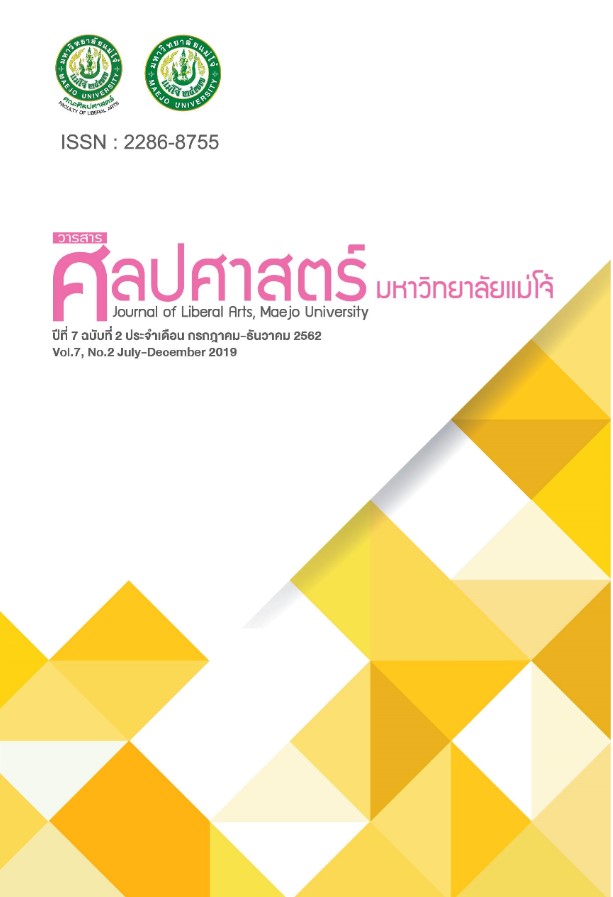The Learning Outcome of English Subject by Lesson One for Kids Application using Augmented Reality Technology
Main Article Content
Abstract
The information technology applied in learning is one factor that will help increasing the learner’s attentiveness to learn more in nowadays, especially English language learning where a number of learners may have learning obstacles. This research aimed as applying virtual technology to help increasing English language learning potential in little children. Thus, the researchers had foreseen the significance in using information technology for the application development. “Lesson One” was the supplementary media for English vocabulary memorizing from the alphabet cards arranging into vocabularies. This would add more enthusiasm in vocabularies memorizing instead of learning words by heart. The researchers had developed the applications according to the learning theory and brought the system to test with the sample group which was 30 of Prathom 2 students from Baan Mae-Joe School. They were 15 of boy students and 15 of girl students, or 50:50 percent from each. It was found from the comparison of the learning results between the students who were taught by a normal teaching method and by the virtual technology method that the learning by using supplementary learning application media “Lesson One” could add more enthusiasm on English vocabularies memorizing in students rather than learning words by heart from the textbook. From the results analyzed by T-Test as measured from English vocabulary memorizing the pre-learning and post-learning testing scores, it was found that learning by Lesson One could increase the potential in English vocabulary memorizing among the students at the statistical significance level of 0.05. The suggestion provided to the future research is to add
more English vocabulary from other categories and to develop games to apply to this learning media.
Article Details
References
เกวลี ผาใต้. (2561). สื่อการเรียนรู้ด้วยเทคโนโลยีมิติเสมือนจริง เรื่อง คำศัพท์ภาษาอังกฤษสัตว์โลกน่ารู้. วารสารโครงงานวิทยาการคอมพิวเตอร์และเทคโนโลยีสารสนเทศ. 4 (1), 23-28.
คมกฤช ทิพย์เกษร. (2551). ระบบความจริงเสริมสำหรับการปรากฏทางไกลเพื่อการเรียนรู้. มหาวิทยาลัยเทคโนโลยีพระจอมเกล้าธนบุรี กรุงเทพมหานคร.
พีรพนธ์ ตัณฑ์จยะ. (2556). การเรียนรู้กระบวนการ Routing Protocol ด้วย Augmented Reality. วารสารวิชาการมหาวิทยาลัยอีสเทิร์นเอเชีย. 7 (2): 51-55.
พฤฒิพร ลพเกด. (2549). โปรแกรมคอมพิวเตอร์เพื่อช่ายประสานภาพพิกัดเสมือน 3 มิติเข้ากับภาพพิกัดจริงบนภาพจากกล้องวีดีโอ. (ปริญญาสถาปัตยกรรมศาสตรมหาบัณฑิต). กรุงเทพมหานคร: จุฬาลงกรณ์มหาวิทยาลัย
มหาวิทยาลัยเกษมบัณฑิต. (2561). เทคนิควิธีสอนที่เน้นการเรียนรู้เชิงรุก (Active Learning). สืบค้น 1 พฤษภาคม 2562 ,จาก http://arch.kbu.ac.th/home/research/pdf/academic/academic001.pdf.
มานะ จันทร์สมบูรณ์. (2553). การรู้จำท่าทางมือโดยใช้คอมพิวเตอร์วิชั่นสำหรับระบความจริงเสริมที่สามารถสวมใส่ได้. กรุงเทพมหานคร: มหาวิทยาลัยเทคโนโลยีพระจอมเกล้าธนบุรี.
วาริน เชาวทัต. (2547). การประมาณตำแหน่งของกล้องเพื่อใช้ในระบบ Augmented Reality. กรุงเทพมหานคร:มหาวิทยาลัยเทคโนโลยีพระจอมเกล้าธนบุรี.
สำนักงานคณะกรรมการการศึกษาขั้นพื้นฐาน. (2561). ข้อมูลพื้นฐาน โรงเรียนบ้านแม่โจ้. สืบค้น 8 มีนาคม 2562. จาก http://data.bopp-obec.info/emis/schooldata-view.php.School_ID=1050130623.
วิลาวัณย์ พรพัชรพงศ์. (2547). เทคโนโลยีความจริงเสริม: ความเป็นมาและการใช้ประโยชน์. วารสารมหาวิทยาลัย ขอนแก่น. 10 (9): 15-25.

